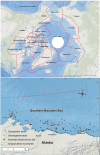Environmental and behavioral changes may influence the exposure of an Arctic apex predator to pathogens and contaminants
- PMID: 29038498
- PMCID: PMC5643432
- DOI: 10.1038/s41598-017-13496-9
Environmental and behavioral changes may influence the exposure of an Arctic apex predator to pathogens and contaminants
Abstract
Recent decline of sea ice habitat has coincided with increased use of land by polar bears (Ursus maritimus) from the southern Beaufort Sea (SB), which may alter the risks of exposure to pathogens and contaminants. We assayed blood samples from SB polar bears to assess prior exposure to the pathogens Brucella spp., Toxoplasma gondii, Coxiella burnetii, Francisella tularensis, and Neospora caninum, estimate concentrations of persistent organic pollutants (POPs), and evaluate risk factors associated with exposure to pathogens and POPs. We found that seroprevalence of Brucella spp. and T. gondii antibodies likely increased through time, and provide the first evidence of exposure of polar bears to C. burnetii, N. caninum, and F. tularensis. Additionally, the odds of exposure to T. gondii were greater for bears that used land than for bears that remained on the sea ice during summer and fall, while mean concentrations of the POP chlordane (ΣCHL) were lower for land-based bears. Changes in polar bear behavior brought about by climate-induced modifications to the Arctic marine ecosystem may increase exposure risk to certain pathogens and alter contaminant exposure pathways.
Conflict of interest statement
The authors declare that they have no competing interests.
Figures

Similar articles
-
Long-term increases in pathogen seroprevalence in polar bears (Ursus maritimus) influenced by climate change.Glob Chang Biol. 2021 Oct;27(19):4481-4497. doi: 10.1111/gcb.15537. Epub 2021 Jul 22. Glob Chang Biol. 2021. PMID: 34292654 Free PMC article.
-
Increased pathogen exposure of a marine apex predator over three decades.PLoS One. 2024 Oct 23;19(10):e0310973. doi: 10.1371/journal.pone.0310973. eCollection 2024. PLoS One. 2024. PMID: 39441768 Free PMC article.
-
Climate-associated drivers of plasma cytokines and contaminant concentrations in Beaufort Sea polar bears (Ursus maritimus).Sci Total Environ. 2020 Nov 25;745:140978. doi: 10.1016/j.scitotenv.2020.140978. Epub 2020 Jul 17. Sci Total Environ. 2020. PMID: 32738684
-
State of knowledge on current exposure, fate and potential health effects of contaminants in polar bears from the circumpolar Arctic.Sci Total Environ. 2019 May 10;664:1063-1083. doi: 10.1016/j.scitotenv.2019.02.030. Epub 2019 Feb 5. Sci Total Environ. 2019. PMID: 30901781 Review.
-
The distribution and trends of persistent organic pollutants and mercury in marine mammals from Canada's Eastern Arctic.Sci Total Environ. 2018 Mar 15;618:500-517. doi: 10.1016/j.scitotenv.2017.11.052. Epub 2017 Nov 13. Sci Total Environ. 2018. PMID: 29145101 Review.
Cited by
-
Giardia and Cryptosporidium in resident wildlife species in Arctic Alaska.Food Waterborne Parasitol. 2023 Aug 29;32:e00206. doi: 10.1016/j.fawpar.2023.e00206. eCollection 2023 Sep. Food Waterborne Parasitol. 2023. PMID: 37692371 Free PMC article.
-
Survival and abundance of polar bears in Alaska's Beaufort Sea, 2001-2016.Ecol Evol. 2021 Sep 23;11(20):14250-14267. doi: 10.1002/ece3.8139. eCollection 2021 Oct. Ecol Evol. 2021. PMID: 34707852 Free PMC article.
-
Reference intervals for blood-based biochemical analytes of southern Beaufort Sea polar bears.Conserv Physiol. 2019 Sep 16;7(1):coz040. doi: 10.1093/conphys/coz040. eCollection 2019. Conserv Physiol. 2019. PMID: 31548889 Free PMC article.
-
Toxoplasma gondii: How an Amazonian parasite became an Inuit health issue.Can Commun Dis Rep. 2019 Jul 4;45(7-8):183-190. doi: 10.14745/ccdr.v45i78a03. eCollection 2019 Jul 4. Can Commun Dis Rep. 2019. PMID: 31355827 Free PMC article.
-
Multi-pathogen serological survey of migratory caribou herds: A snapshot in time.PLoS One. 2019 Jul 31;14(7):e0219838. doi: 10.1371/journal.pone.0219838. eCollection 2019. PLoS One. 2019. PMID: 31365561 Free PMC article.
References
Publication types
MeSH terms
Substances
LinkOut - more resources
Full Text Sources
Other Literature Sources
Miscellaneous

